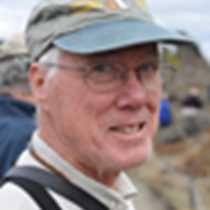Endicott Arm & Williams Cove, Alaska
We awoke on the first morning of our trip through Southeast Alaska in one of its most scenic spots – the Tracy Arm / Ford’s Terror Wilderness. Tracy Arm and Endicott Arm are fjords – steep-sided, narrow valleys that cut some thirty miles into the mainland of North America. They were carved by the recurrent passage of glaciers from land to sea as the ice has waxed and ebbed over the 2 ½ million years of the Ice Ages. Now, during the current warm interglacial episode, they are flooded by the sea to form the waterways of Southeast Alaska. We turned into Endicott Arm, the southernmost of the two. Heading up the fjord, we scanned the water and shoreline for birds (saw lots) and mammals. We found mountain goats – white spots with horns clinging to impossibly steep slopes above us. Ice floating in the water told us that we were approaching the glacier at the head of the fjord. We made one last turn and there it was in all of its blue-white glory: the Dawes Glacier, nearly a mile in extent from side to side, 200 feet high at its face, originating in the Stikine Ice Field in the mountains that divide Alaska from British Columbia. We bundled up and boarded our Zodiacs for a closer look. The ice that appears so blue in the face of the glacier and in larger icebergs and “bergy bits” is as clear as the finest crystal glass in smaller floating pieces. Other pieces had embedded dirt and rocks that were picked up in the mountains and transported down to the sea by the incessant movement of the glacier. Harbor seals were resting on the ice and delicate Arctic terns, newly returned from their winter trip to Antarctica, were choosing their mates for the breeding season to come.
We returned down Endicott Arm to Williams Cove for our afternoon activities. Our fleet of kayaks came down from the top deck and we had our first opportunity to paddle gracefully in perfect synchrony … or not … in the quiet water of the Cove. We are in the period of spring migration and the birds are at the peak of their breeding finery. We had excellent views of goldeneyes, scoters, harlequin ducks, and more. Williams Cove also offered a chance to walk through the forest following a bear trail, and along the beach. We didn’t go far because there was so much to see, so much to learn about the Temperate Rainforest of Southeast Alaska, from the giant Western hemlock and Sitka spruce that make up the forest canopy to the mosses, lichens, and ferns draped on branches and covering the forest floor. The forest is just coming alive after its winter rest, the leaves and delicate pale-pink flowers of early blueberry just appearing, the bright yellow flowers and rubbery green leaves of skunk cabbage pushing up as the snow recedes.
We awoke on the first morning of our trip through Southeast Alaska in one of its most scenic spots – the Tracy Arm / Ford’s Terror Wilderness. Tracy Arm and Endicott Arm are fjords – steep-sided, narrow valleys that cut some thirty miles into the mainland of North America. They were carved by the recurrent passage of glaciers from land to sea as the ice has waxed and ebbed over the 2 ½ million years of the Ice Ages. Now, during the current warm interglacial episode, they are flooded by the sea to form the waterways of Southeast Alaska. We turned into Endicott Arm, the southernmost of the two. Heading up the fjord, we scanned the water and shoreline for birds (saw lots) and mammals. We found mountain goats – white spots with horns clinging to impossibly steep slopes above us. Ice floating in the water told us that we were approaching the glacier at the head of the fjord. We made one last turn and there it was in all of its blue-white glory: the Dawes Glacier, nearly a mile in extent from side to side, 200 feet high at its face, originating in the Stikine Ice Field in the mountains that divide Alaska from British Columbia. We bundled up and boarded our Zodiacs for a closer look. The ice that appears so blue in the face of the glacier and in larger icebergs and “bergy bits” is as clear as the finest crystal glass in smaller floating pieces. Other pieces had embedded dirt and rocks that were picked up in the mountains and transported down to the sea by the incessant movement of the glacier. Harbor seals were resting on the ice and delicate Arctic terns, newly returned from their winter trip to Antarctica, were choosing their mates for the breeding season to come.
We returned down Endicott Arm to Williams Cove for our afternoon activities. Our fleet of kayaks came down from the top deck and we had our first opportunity to paddle gracefully in perfect synchrony … or not … in the quiet water of the Cove. We are in the period of spring migration and the birds are at the peak of their breeding finery. We had excellent views of goldeneyes, scoters, harlequin ducks, and more. Williams Cove also offered a chance to walk through the forest following a bear trail, and along the beach. We didn’t go far because there was so much to see, so much to learn about the Temperate Rainforest of Southeast Alaska, from the giant Western hemlock and Sitka spruce that make up the forest canopy to the mosses, lichens, and ferns draped on branches and covering the forest floor. The forest is just coming alive after its winter rest, the leaves and delicate pale-pink flowers of early blueberry just appearing, the bright yellow flowers and rubbery green leaves of skunk cabbage pushing up as the snow recedes.




